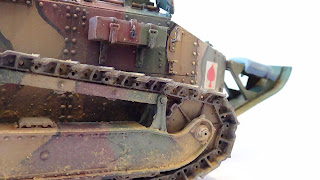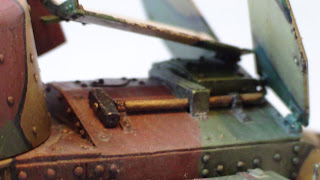Hi everyone,
Since I’m finished with most of the “building” part of the renault FT diorama. I started to work on a new project. It’s a project that I thought I would never have the opportunity to work on one day but
Retrokit made it possible when they released this year in March the Belgian T13 type I/II in 1/35th scale. I’m not really good at scratch building and I thought this vehicle would never be commercialized by any manufacturer but here it is.
But… what’s a T13?????
T13 type 2
T13 type 2
Well the T13 type I/II tank or preferably tank destroyer was basically a Vickers Carden Loyd 1934 artillery tractor fitted with a Belgian F.R.C. built 47mm anti-tank gun. This AFV was (too) lightly armored, not entirely closed (armored shields needed to be lifted upwards to protect the crew but no “roof” was foreseen) and was made to fire backwards. Nevertheless, the main armament, the Belgian 47 mm anti-tank gun, gave the T13 a very nasty bite and could easily knock down any German afv in 1940. It could fire both armor-piercing and high explosive rounds and giving the T13 anti-tank or anti-infantry capability. The secondary armament consisted of a FN built M1918 Browning Automatic Rifle and could be mounted in the turret next to the main gun but could also be easily used out of the vehicle.
The T13’s were the most numerous afv’s in (and also, in my opinion, the most emblematic vehicle of) the Belgian army in 1940. About 32 T13 type I, 21 T13 type II and 250 T13 type III were built (the numbers of T13's built vary from one source to another, this is an estimation). The only known surviving example (T13 type II) can be seen at the Musée Royal de l’Armée (MRA) in Brussels and still wear its original camo and markings, it was found in a Museum’s cellar in Austria and returned to Belgium in the 1980ies. The type I’s and II’s differ little from each other: the main visible differences can be seen in the rear mudguards (almost horizontal on type I and vertical on type II), the tow hook (“in stairs” on type I and beefier on type II) and (sometimes) the number of hinges on the side armor plates (most of the time 5 on type I and 3 on type II). The type I’s were actually tractors built in Belgium under license and immediately fitted with the 47mm gun whereas the type II’s were imported British built artillery tractors that were converted. The T13 type III was based on the Vickers Carden Loyd Light Dragon Mk. II B and was an improved version of the T13’s type I/II. It was altogether a completely different vehicle than the T13 type I/II with a stronger engine, bigger tracks, return rollers and provided a better platform for the Belgian 47mm gun. The all concept was reviewed, the turret got redesigned, the armor increased and the T13 type III was meant to fire forward instead of backwards. As regards the crew, the T13’s type I / II had a crew of 3 and the type III had a crew of 4.

T13 type 3
During the 18 days campaign in May 1940 these afv’s proved to be effective thanks to their powerful armament but suffered from mechanical problems and were not efficiently used. They were distributed in small groups of one or two vehicles to support the infantry and despite some local successes they got overwhelmed by the far more powerful and better organized German Panzerdivisionen.
Who’s Retrokit? And… what’s in the box?
Retrokit (Dominique Jadoul) is a Belgian manufacturer of resin kits who originally produced conversion sets for planes and kits and figures in 1/72th scale of subjects which were rarely seen in modelling at the time. The Retrokit catalogue grew during the years and new categories appeared with nice products in the SF (science fiction) range and also brand new conversion sets for Meng’s “Toon tanks”. These last years Retrokit also started releasing 1/35th scale kits related to the Belgian army. The first of these was the
M75 Full Track and the second the
T15. The next kit to be released really soon (October 2018) is the
47mm FRC gun as a standalone antitank cannon. Two figures of Belgian tank crew (35-40) are also available.
The
T13 type I/II is thus the third 1/35th full kit of this producer and is, as far as I know, the very first 1/35th kit of the T13 of any type.
When I heard that this kit would be released I immediately ordered one and I received it by post as soon as the first castings were done. The kit was very well packed to avoid any damaged during the shipping.
What surprised me when I opened the little box was the consequent amount of well casted resin pieces, and the high level of details. The grey resin is not too hard nor too soft and seems to react good to warm water in case you need to reshape some lightly bent parts. Among the biggest parts we can distinguish: the hull casted in one piece with the chassis, the gas tank casted together with some ammo shelves to be placed at the back of the vehicle, the turret, the front « hood », the front and side armor plates and the engine.



As you will have noticed, the T13 type I/II is an open top vehicle and the number of details to be reproduced is really impressive. By having a closer look at this, we notice that Retrokit did a pretty good job here because almost all the parts that can be seen in the existing documentation and also on the last surviving example in Brussels are included in the kit. All the parts of the engine are reproduced, only some cables that you can make out of copper wire (or another material) are lacking. The details are finely casted and altogether we feel that the pattern maker (Dominique Jadoul) has really well studied and designed the kit.
The kit allows you to build a T13 type I or II.
Type I : the mudguards are almost horizontal, the tow hook is shaped in « steps » and, most of the time, the side armor plates have 5 hinges.
Type 2 : the mudguards are almost vertical, the tow hook is beefier and, most of the time, the side armor plates have 3 hinges. This is the version of the surviving T13 exposed in Brussels (see the two first pictures above).
The running gear is quite simple : each side is made of one sprocket and four road wheels.
The tracks that are included in the kit are in resin and are length-and-link tracks. These are Panzer I tracks that will fit the T13’s running gear and will need a bit of cleaning work but I believe they can be used to achieve a proper result… I’ll have a look later on this when I’ll assemble them. In the worst case, if you do not feel comfortable using these, Retrokit suggests to replace them by individual Panzer I’s Modelkasten or Masterbox track links.
A lot of small parts will help you detailing the engine, the gun and the interior of the hull. The decals included in the kit are just a little sheet of generic markings allowing you to reproduce the basic markings (license plate and Belgian roundels) of any T13 type I or II but do not include any unit markings. So if you want to reproduce these (which were often very attractive on this vehicle), you will have to make your own decals or to paint the markings on your own on the vehicle.
The kit is very original and the detail is high and crisp. The casting is altogether quite good: I only found some defaults on the hull on the front and at the rear of the vehicle but these are rapidly fixed with sand paper, a little plastic card and CA glue (or putty). The main parts fit really well and if certain parts might be slightly torn (during the cleaning process for example), you can easily reshape them with hot water. The resin is easy to work with, it’s neither too hard nor too soft.
You will have to take into account that it is typically a little resin manufacturer’s kit meaning that there’s a lot of cleaning up to do. For example, you will have to remove a big casting block under the hull (see pic). Other casting blocks will require attention in order not to break some fragile parts and some flash need to be removed. The instructions are made out of pictures and explanations in English but a good documentation could be here very handy. The following website offers a good walkaround of the T13 presented in Brussels:
maquetland T13.




This is a personal opinion but, to me, the negative point of this kit is the (too) soft casting of the rivets. I find these not visible enough and I think they will disappear under a coat of primer. In my opinion they need to be improved and this is quite a bit of work. Here’s a pic showing the hull from close up. I’m not a rivet counter but I do like using these during the weathering stage because these are an opportunity to bring life into the model.

In conclusion, I warmly recommend this kit for any modeler with a bit of experience and looking for building something “different” and “exotic”. It’s not a starter’s kit because there’s much cleaning work to do, attention must be paid not to break any parts and it’s preferable to gather some documentation. The parts seem to fit quite well and I believe this kit will be a very nice reproduction of this surprising and almost confidential little tank hunter if you are not afraid spending some effort that a classic resin kit usually requires. Thank you Retrokit for making such unusual and interesting vehicles!!!
Stay tuned for the start of the building very soon.
Happy modelling!





















































